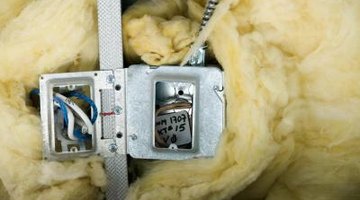Minnesota State Building Code for Basement Insulation
Basement walls and floors have special problems when it comes to insulation, according to the Minnesota Department of Commerce Energy Information Center, because they’re prone to flows of moisture coming from both the inside and the outside of the building. This moisture makes them more susceptible to mold problems, especially if they’re not insulated properly.
New Homes

New homes in Minnesota are required to have foundation wall insulation installed, although homeowners who are finishing off an existing basement aren’t required to add insulation. Using rigid fiberglass or some other type of inflexible insulation to insulate the outside wall helps reduce dampness by keeping surface water and groundwater away from the foundation. In addition, interior condensation is reduced, because the basement walls remain at room temperature.
R-value
Insulation is assigned an R-value depending on how well it resists the flow of heat. Good insulation has a high R-value. Minnesota law requires that insulation in foundation walls have a minimum R-value of 10. Slab insulation must also have an R-value of 10, to a depth of 5 feet below grade. The insulative value of mass walls such as rammed earth, logs or concrete blocks must be R-15. Adding extra insulation to increase the R-value of a foundation wall assembly isn’t permitted unless you’re using fiberglass batt insulation on the inside. Foundations and basements in buildings with a permit originally issued before June 1, 2009, are exempt from meeting insulation R-values.
Air Barrier
Minnesota’s building code requires that an air barrier be installed on the warm side of insulated ceilings and walls. Air barriers can be made from gypsum board, plywood or even 4-mil polyethylene, as long as it’s sealed. Air barriers must be sealed in a number of places, including joints, seams, and where plumbing or electrical materials penetrate the insulated wall. Methods of sealing include caulking, gasketing and weatherstripping. Sealing the air barrier will prevent moist air from leaking into your basement. Foundations and basements in buildings with a permit originally issued before June 1, 2009, are exempt from meeting air barrier requirements.
Insulation Assemblies
Insulation assemblies installed on the outside of a foundation have to be manufactured from water-resistant materials with a rigid, nontransparent protective covering that keeps the thermal properties of the insulation from breaking down. In addition to covering the exposed insulation, the protective covering has to extend at least 6 inches below grade. Two rules apply to basement walls with interior insulation assemblies: If there’s a frame wall, it can’t touch the foundation wall unless the foundation wall is waterproofed, and masonry foundation walls must drain to an approved drainage system through the masonry block core.
Other Rules
Minnesota requires basement foundation walls to be insulated from the top of the wall to the top of the footing. If the insulation is installed on the inside, it must be insulated from the top edge of the interior wall to the top of the slab. Insulation on buildings with slab-on-grade or basement walkout foundation walls must run to the frost line or the top of footing, whichever is less.
References
Writer Bio
Lani Thompson began writing in 1987 as a journalist for the "Pequawket Valley News." In 1993 she became managing editor of the "Independent Observer" in East Stoneham, Maine. Thompson also developed and produced the "Clan Thompson Celiac Pocketguides" for people with celiac disease. She attended the University of New Hampshire.
Photo Credits
- Jupiterimages/Photos.com/Getty Images
More Articles
- What Is the Width of an Average Wall?
- What Kind of Insulation Should Be Put Under a Concrete Slab in a Garage?
- Heating a Brick House Vs. a Wood House
- How to Insulate an Exterior Face of a Concrete Block Wall
- How to Convert R-Value to U-Factor in Insulation
- The Average Cost of Repairing a Bowed Basement Wall



